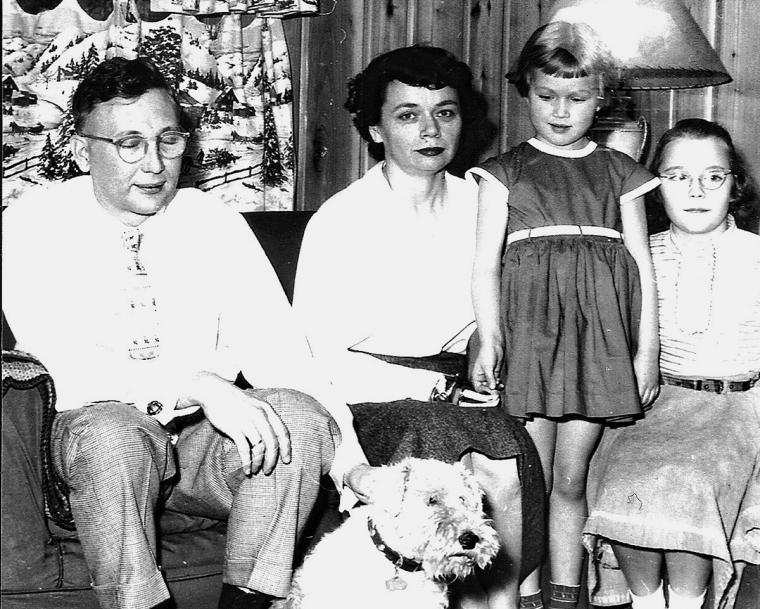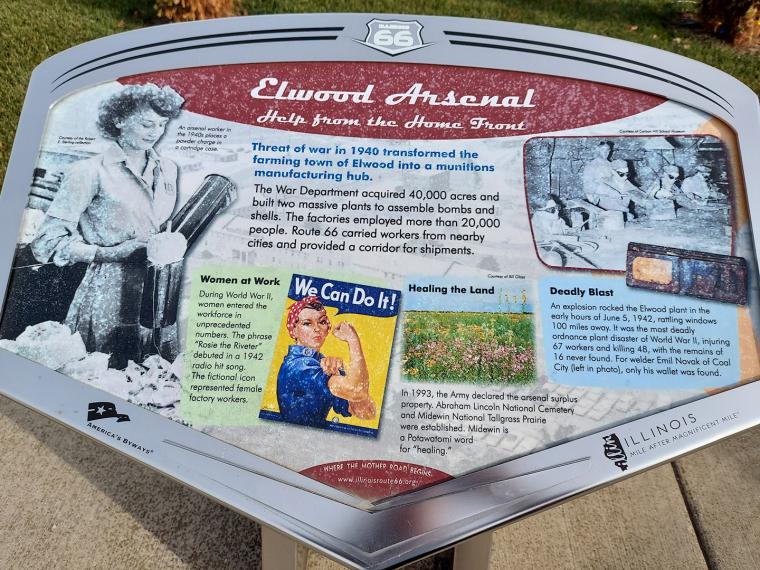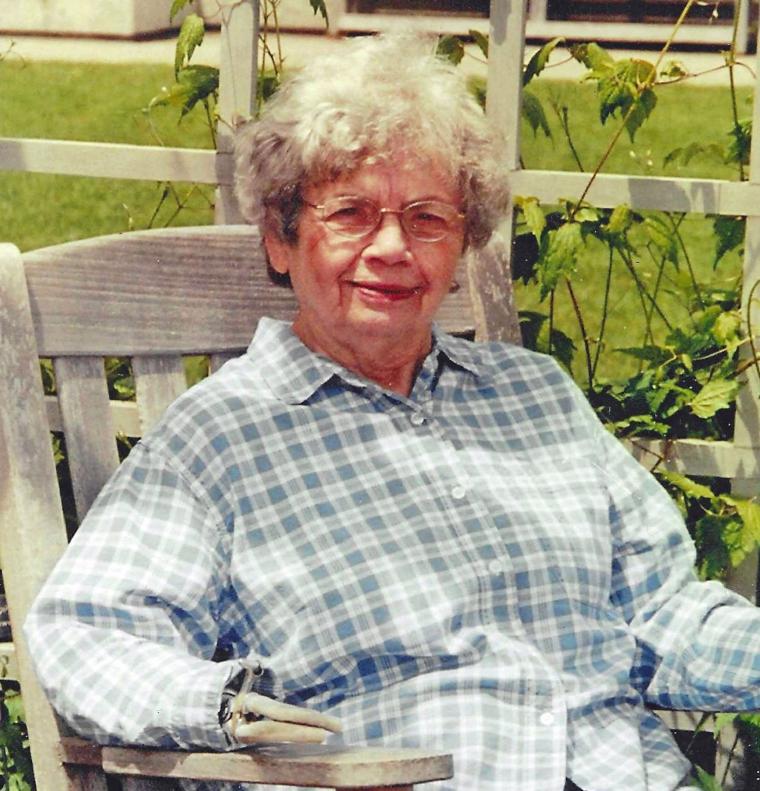
Mary Fernald Schrenker is pictured second from left, along with her husband and two children. Janet Bender is closest to Mary
MONMOUTH, ILLINOIS (March 1, 2024) — Memorial Day and Veterans Day are both times to honor individuals who served in the military, and Monmouth College has had its share, including four alumni who received the Congressional Medal of Honor, the armed forces’ highest military decoration for personnel who distinguished themselves through acts of valor.
The two national holidays conjure images of soldiers in combat. But not all individuals who made great personal sacrifices during wartime served in the military or came into harm’s way on the battlefield.
Consider the case of the late Mary Fernald Schrenker, who was born in Larchland, Illinois, the youngest of nine children. She grew up in Monmouth, then followed five of her Fernald siblings to Monmouth College — Herb (’35), Rob (’37), Joyce (’39), Sarah (’41), and Leon (’42).
While many of the other young women on campus were studying to be teachers or were involved with the fine arts, Mary took on the rigors of chemistry with legendary professors William Haldeman and Garrett Thiessen. She graduated in 1942 during the first year of US involvement in World War II, and her chemistry degree was immediately put to use, as she served as a lab tech at the Kankakee (Illinois) Ordnance Works.
In harm’s way
The plant was one of more than sixty constructed between June 1940 and December 1942 to manufacture military munitions, a process that required specialized equipment and techniques. The boom in construction was an attempt to avoid the confusion and waste experienced two decades earlier during the mobilization effort for World War I.
Kankakee Ordnance Works and its sister plant roughly twenty miles to the northwest, the Elwood Ordnance Plant, were two of the first five plants to be constructed (and would, years later, be known collectively as the Joliet Army Ammunition Plant). During peak production, the two facilities employed more than 17,000 people from 36 states.

Elwood Arsenal artifact
The plants were separate because they had different purposes. Kankakee manufactured various types of explosives for use at other plants, while Elwood loaded artillery shells, bombs, mines, and other munitions. During the course of World War II, Elwood produced a staggering number of bombs, including more than 3,000 two-ton bombs and, combined, more than half a million 250- and 300-pound bombs.
It was a simple fact of life that the plant’s employees were putting themselves in harm’s way. In fact, shortly before Mary began working at Kankakee, a large explosion on a loading line of railroad cars killed 48 people at the Elwood plant. The blast, with an explosive weight equal to approximately 62,600 pounds of TNT, was felt as far as sixty miles away and reportedly heard 100 miles away in Waukegan, Illinois. It was the deadliest US ammunition plant incident of World War II and one of the deadliest industrial accidents in state history.
Setting the stage
When Mary began working at Kankakee, she was one of more than 10,000 people employed at the two plants. Most of the female employees did secretarial work, but Mary was one of the exceptions.
Although this Monmouth connection wasn’t known at the time, she worked for a young Bernard Ryder, who would eventually have a daughter, Mary Ryder, who became a 1972 Monmouth graduate. A distinguished professor emerita at South Dakota State University, Ryder has returned to Illinois, living in Normal, not far from the Illinois State University campus, where her father taught chemistry for 28 years.
“She was working next to my dad, who was one of seven lead scientists on the project,” said Ryder. “At 24, he was actually on the older end of the lead team, which had an average age of 23.”
Ryder recently donated her father’s lab manual — an 86-page, three-ring notebook — to the National WWII Museum in New Orleans. Officials there told her they didn’t have anything like it in their Home Front Production Collection.
“I made a copy and sent them the original,” said Ryder. “It’s full of very technical material concerning the work they were doing at Kankakee.”
Also working in the lab was its supervisory chemist, Bernard “Ben” Carlson, whose son, John, went on to become a professor of astrophysics, retiring a few years ago from the University of Maryland. It’s possible John Carlson and Mary Ryder met as youth, but they’ve definitely connected recently as Ryder has dug deeper into her father’s World War II assignment.
“My dad stayed friends with several of the chemists for a number of years, and Mom wrote Christmas cards to the Carlsons,” said Ryder.
Ryder didn’t learn Mary’s full name until a recent conversation with Carlson, “and that’s when I put the two together,” she said of their Monmouth ties. “Some of the parallels between John and my family were pretty freaky, and then I was really freaked out when I realized that this woman who I’d heard stories about as a child had also gone to Monmouth.”
A fateful day
Carlson provided details about what lab work was like at Kankakee.
“The main product was TNT — trinitrotoluene,” he said. “They also made a tricky, unstable detonator from lead azide.”
There were twelve TNT lines at Kankakee and six DNT lines. And Kankakee was the only facility in the system producing lead azide, which Carlson called “a pretty scary chemical.”
“In my father’s lab, they were working on better ways to make it, store it and package it,” he said. “It was unstable and dangerous.”
The lab manual read, “Everyone connected with the plant should always bear in mind that lead azide is a primary explosive and has to be respected. Safety rules are to be carried out exactly.”
“The bench chemists, like Mary, would have both examined the samples microscopically and used the ‘drop’ test to determine the nature of the sample,” said Ryder. “The latter was the really dangerous part. . . It was nearly as dangerous going into that lab as it was into the battlefield.”
From there, Carlson let his late mother — also named Mary — take over what he called “a really extraordinary story,” based on a conversation he had with her sometime after her 101st birthday in 2018.
“My mom and I could always talk about anything,” said Carlson, whose father died in 2002. “As she aged, she remained quite sharp. One day, I said something like, ‘When Dad was at the Joliet Arsenal at Kankakee, do you remember a story about an accident?’ She said, ‘Oh, yes. There was an explosion. A woman lost her hands and arms in the lab. Your dad was devastated. Her name was Mary, the same as mine. Mary Fernald.’
“Then I asked her, ‘Do you remember what specifically happened?’ She said, ‘They were in the lab, working on dangerous explosives. It just exploded.”
The detonation velocity of lead azide is approximately 17,000 feet per second.
Added Carlson, “In an instant, she lost not only her hands but her lower arms completely. Everybody came rushing in to save her.”
Carlson, who was born in Joliet in 1945, continued the recollection of his conversation with his mother.
“She said, ‘It was such a crisis, but she recovered and she got married.’ I said, ‘Do you know what it was that exploded?’ She said, ‘It was lead azide.’ It was just amazing to me that it was right there in her mind after all that time — more than 75 years — had passed. How could she remember that? It’s remarkable what this shows about the deep, deep power of memory, of trauma, of compassion, and how they as a couple felt about the accident.”

Mary Fernald Schrenker in later years
And that compassion was definitely present, according to both Ryder and Carlson.
“It was no one’s fault,” said Ryder. “Mary was working with a bad sample. Dad carried a burden of guilt for years, and John’s father blamed himself for the accident since he was the supervisor of that lab, though, of course, the accident wasn’t his fault. John’s mother wrote to Mary for years.”
“It was a horrible accident,” said Carlson. “My dad felt so bad, but it was nothing he’d done wrong. He had that collection of emotions you feel when it’s something that happened under your watch, like a lieutenant might feel about a battle. Just the horror of it.”
The rest of the story
That Mary survived the ordeal is, in itself, a miracle, and then she went on to live another seven decades — including more than half-century in Roseville, Minnesota — dying in 2012 at the age of 91. Her surviving daughter, Janet Bender, filled in some details about her mother’s next seventy years.
“She was a pretty fabulous lady, well-respected,” said Bender, who reported that following the accident and her recovery, Mary went to Los Angeles with her sister-in-law.
“They stayed there several months so that Mom could learn about her prosthetics and how to use her hooks for hands,” said Bender. “One of the things she told me about that time was she was taught how to put on her make-up by the women who did make-up for the stars. At the cafeteria they had there, she saw Generak Omar Bradley,” who would, less than two years later, serve as field commander during the Allied invasion of Normandy on D-Day.
Another employee at the Kankakee plant was Bill Schrenker, who would eventually have a career with 3M.
“Mom and Dad met at the plant, and Dad stayed with her after the accident,” said Bender. “There’s a story from their wedding that her future mother-in-law was crying, because her son was marrying a crippled, handicapped person.”
But despite such prejudices, the Schrenkers got along just like any other family. It just took some “ingenuity” sometimes.
“Her and Dad were ingenious,” said Bender. “They always had to be inventing something, like pads to cover her hooks. Before the accident, she and Dad had done horseback riding, and she was starting to get into golf. So Dad even tried to design golf clubs she could use. I’m not sure that they turned out, but at least they tried.”
Those inventions, combined with her mindset, helped Mary remain, in her daughter’s words, “independent” and “self-sufficient.”
“She wanted to be self-sufficient, and she was an inspiration to so many people,” said Bender. “One of them was the church organist, who struggled with rheumatoid arthritis. She was in a lot of pain, but after watching my Mom’s example for so many years, she told herself, ‘If she can do it, I can do it.’”
Mary’s self-sufficiency included learning how to sew and getting behind the wheel of a car.
“She pushed for independence,” said Bender. “When she wanted to start driving, no one would insure her. The Hartford Co finally did, and she didn’t have an accident until she was 84, and it wasn’t her fault.”
Simply put, Bender said her mother “just never made a big deal about her hands.”
“Others would, of course. I remember that little kids would point at her. My children are deaf, and I remember one time Mom and I were shopping with my kids, and a woman was watching us. She said something like, ‘Oh, my goodness. So much bad has happened to your family.’ Mom and I just looked at each other, like ‘What? Isn’t everybody like this?’”
Mary could relate to her deaf grandchildren. As a result of the explosion, she lost a great deal of her hearing. (Her eyesight, however, was fine, as the safety glasses she was wearing did their job perfectly).
“When it came time to teach my kids to communicate, we had to decide on whether the main focus would be to sign or to be oral,” said Bender. “Even though she had hooks for hands, Mom said, ‘By all means, go with sign language.’ She would study for hours and watch DVDs, so she could understand what my kids were saying to her when they were doing things like asking for more, or for milk.”
Years after the fact, Bender heard a heartwarming story about her mother.
“At Mom’s funeral, the daughter of a neighbor lady who used to play bridge with Mom told me a story about when she was a child, around five, six, seven years old. She said she asked Mom, ‘What are those hooks for?’ Mom said, ‘They’re for picking up little girls and swinging you around.’”
“Home front hero”
Mary’s obituary said she “cheated death” in an accident involving detonators for World War II weapons.
“She fought hard to survive, but lost both hands in the accident,” reads the obit. “She worked hard to rehabilitate herself, then married, and had two daughters.”
The obituary continued, “She was a loving and gracious person who touched everyone she met. She will not be easily forgotten, and her bright blue eyes and loving heart will be sorely missed.”
“I heard her story throughout my growing up,” said Ryder. “The tragedy of the incident plagued, I think, all of the chemists who were at work there. Mary Schrenker was a home front hero. She made a sacrifice.”
“I’ve always remembered her name from my parents talking about her – Mary Fernald,” said Carlson. “She recovered and continued on with a full life. She even had children, which makes it a story with a good ending.”
One of those children appreciates that a longer version of her mother’s story is finally being told.
“This is something I have wished for for a long time,” said Bender. “How does someone so special leave this world without someone noticing?”








